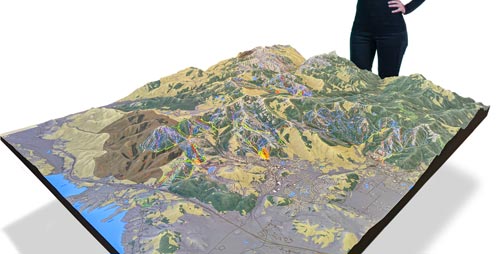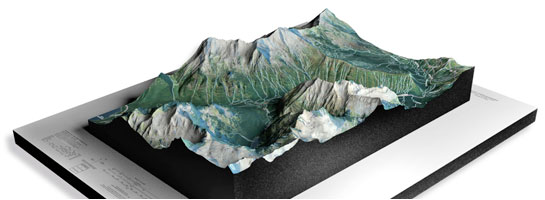Maps Glossary
WhiteClouds builds 3D Raised Relief Maps
Did you know we make
3D raised-relief maps

and
3D raised-relief maps

Oasis
An oasis is a small area in the desert that has water and vegetation. It is a welcome sight for travelers who are traversing the hot and arid desert. Oases are typically formed where underground water comes to the surface. They can be a few meters to several kilometers wide and are surrounded by dry and barren land. Oases are important habitats for wildlife, and they are often used as a source of water for local communities.
Oblique Aerial Photography
Oblique aerial photography is a technique used to capture images of the earth’s surface from an aircraft at an angle. In this type of photography, the camera is tilted to one side, and the resulting image has a three-dimensional perspective. Oblique aerial photography is commonly used for mapping, surveying, and creating three-dimensional models of landscapes. It can also be used for architectural and urban planning purposes.
Oblique Projection
Oblique projection is a type of projection used in technical drawing and engineering. In this type of projection, the object being drawn is shown at an angle to the viewer. Oblique projection is often used to show the features of an object that are not visible in a standard orthographic projection.
Ocean Current
An ocean current is a continuous, directed movement of ocean water. Ocean currents are driven by various factors, including wind, temperature, and the Earth’s rotation. They can be shallow or deep and can cover vast distances. Ocean currents are important for transporting heat, nutrients, and other substances around the world’s oceans. They also have a significant impact on weather patterns and climate. Some well-known ocean currents include the Gulf Stream, which brings warm water from the tropics to the North Atlantic, and the California Current, which flows southward along the west coast of North America.
Ocean Current Map
An ocean current map is a type of map that shows the direction and strength of ocean currents. These maps are important tools for scientists and sailors who need to understand the movement of ocean water. Ocean current maps are created using data from satellites, buoys, and ships. They are typically color-coded to indicate the speed and direction of currents.
Oceanic
Oceanic refers to anything that is related to the ocean. It can be used to describe the plants, animals, and other living organisms that live in the ocean. It can also be used to describe the physical properties of the ocean, such as its depth, temperature, and salinity. Oceanic is often used in contrast to terrestrial, which refers to things related to the land.
Old-growth Forest
An old-growth forest is a forest that has not been disturbed by human activity for a long period of time. These forests are characterized by large, mature trees that have been allowed to grow and mature naturally. Old-growth forests are important habitats for many species of plants and animals, and they are also important for carbon sequestration. They are often protected by conservation efforts, as they are rare and valuable ecosystems. Old-growth forests are also important for scientific research, as they provide a glimpse into the natural history of an area.
Oligocene
The Oligocene is a geological epoch that occurred approximately 33.9 to 23 million years ago. During this time, the Earth’s climate was relatively warm, and the first grasses and modern mammals evolved. The Oligocene is important for understanding the evolution of many plant and animal species, as well as for studying the geological history of the Earth.
One Hundred Year Flood
A One Hundred Year Flood is a type of flood that has a 1% chance of occurring in any given year. This does not mean that a One Hundred Year Flood will occur only once every hundred years, but rather that it has a 1 in 100 chance of occurring in any given year. These floods are often caused by heavy rainfall, snowmelt, or a combination of both. One Hundred Year Floods can cause significant damage to homes, businesses, and infrastructure.
Onshore
Onshore refers to land that is adjacent to or near the sea or ocean. It is the opposite of offshore, which refers to areas that are located away from the shore. Onshore areas can include beaches, cliffs, and coastal plains.
Open space
Open space refers to areas of land that are not developed or used for specific purposes. These areas can include parks, natural reserves, and undeveloped land. Open space is important for preserving natural habitats, providing recreational opportunities, and improving the quality of life for people living in urban areas.
Orientation
Orientation refers to the direction or position of an object or feature relative to another object or feature. It is an important concept in geography, cartography, and navigation. Orientation can be described using cardinal directions (north, south, east, west) or by degrees of a compass.
Orthographic Projection
Orthographic projection is a method of representing a three-dimensional object in two dimensions. In this type of projection, the object is viewed from a fixed position and each side is projected onto a plane. Orthographic projection is commonly used in engineering and architecture.
Orthophoto
An orthophoto is an aerial photograph that has been corrected for distortions caused by camera angle and terrain relief. Orthophotos are used in mapping and surveying and can provide accurate measurements of distances and areas.
Orthophoto Map
An orthophoto map is a type of map that is created using orthophotos. It is a highly accurate representation of an area and can be used for a variety of purposes, including urban planning, land use management, and environmental monitoring.
Outcrop
An outcrop is a visible exposure of bedrock or other geological formation on the Earth’s surface. Outcrops can be found in many different environments, from mountain slopes to riverbanks. They are important for geological research and can provide insight into the history of an area.
Outwash
Outwash is a type of sediment that is deposited by melting glaciers. It is composed of sand and gravel and is often found in the form of large ridges or hills. Outwash deposits can be important sources of groundwater and can also be used as construction materials.
Overburden
Overburden is the layer of soil or rock that covers a mineral deposit or other resource. It is typically removed during mining operations to access the underlying resource. Overburden can contain valuable minerals or other resources and may be processed to recover these materials.
Overland Flow
Overland flow is the movement of water over the Earth’s surface. It can occur when precipitation exceeds the ability of the soil to absorb water, or when the ground is saturated. Overland flow can cause erosion and sedimentation and can also be an important source of water for plants and animals.
Overthrust Fault
An overthrust fault is a type of fault in which one block of rock is pushed up and over another block. This can occur when pressure builds up between two tectonic plates, causing one plate to slide on top of the other. Overthrust faults are commonly found in mountainous regions and can cause significant geological activity.
Ox-bow Lake
An ox-bow lake is a crescent-shaped body of water that is formed when a meandering river changes its course. Over time, the river erodes the outer banks of a bend, causing the water to flow faster on the inner banks. This causes the bend to become more pronounced, eventually creating a loop that is cut off from the main river channel. The result is an ox-bow lake, which can provide important habitat for wildlife and recreational opportunities for humans.
Oxidation
Oxidation is a chemical reaction in which a substance loses electrons, resulting in a change in its chemical composition. This reaction often involves the combination of oxygen with other elements or compounds. Oxidation can occur naturally, as in the rusting of iron, or can be artificially induced, as in the case of burning fossil fuels. Oxidation can have a variety of environmental impacts, including air pollution and the degradation of natural resources. It is an important process in many industries, including metal production and water treatment.